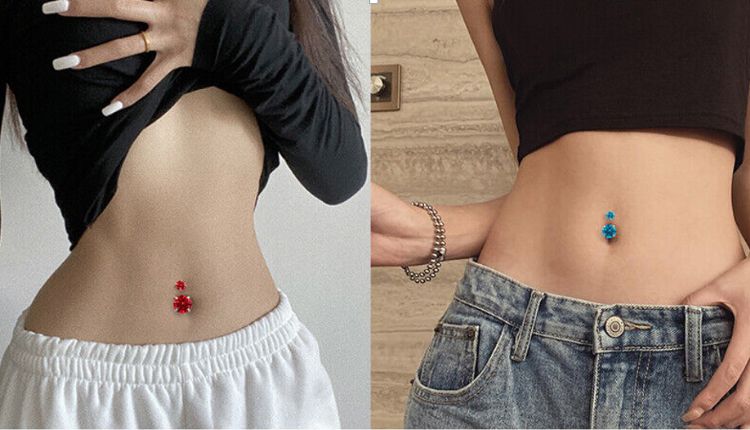Whether or not you already have one, are thinking of getting one, or are just curious about it, there is more to the belly button piercing than meets the eye. Over the past few decades, belly button piercings have become quite a trend, and they are one of the most fashionable types of body modification today. However, before you snag a slot at your local piercing studio, there are plenty of things to know for a safe, seamless—and chic—experience. Here’s what to know about belly button piercings, including aftercare and the pros and cons.
Everything You Need to Know About Belly Button Piercings
Belly button piercings, or navel piercings, are performed by piercing the skin that surrounds the navel and inserting a piece of jewelry. Placement is typically through the center top of the navel, where there is little mobility and excess skin to help hold up the jewelry. This body piercing has seen extensive popularity amongst youth and youngsters, especially among the age of people who like to have an aesthetic movement to their appearance.
Belly button piercings go in and out of fashion, but they are not for everyone. Things like skin type, body shape, and personal hygiene practices all make a difference in whether you are a good candidate or not. For example, people with larger navels are more likely to sustain and decorate these piercings compared with others who have small navels.
Selecting the Best Studio and Person for Your Piercing
Finding a good studio and piercer is important for safety. What to look for when choosing a piercing studio.
Licensing and Certifications: Confirm the studio is licensed to operate by local health authorities and that the piercer can provide their certificates.
Hygiene: The environment in which you receive your Piercing should be clean, and the piercer should wear gloves and use sterilized equipment. Anything that can be tossed (needles) should go in the trash after one use.
Experience: A professional piercer with experience doing your specific type (i.e., belly ring) of Piercing may minimize complication risks.
Reviews/Testimonials: Before hopping onto numerous forums and reading customer reviews, one must take a dive into the studio’s reputation to try and be sure they are providing quality service.
The first step in safe Piercing is to find a good studio, which you have already done.
How Do Piercings Work and What Exactly You Can Expect
The actual piercing process is fast and surgical, usually only needing a couple of minutes max. First, let me walk you through the steps:
Preparation: The piercer cleans and marks the area near your navel before piercing.
Piercing: the opening is made using a sterilized, hollow needle, and jewelry is put in at the same time.
Aftercare Instructions: Your piercer will provide you with care instructions to ensure the wound heals properly.
A small poke or discomfort should be expected during the Piercing, but, of course, this varies from person to person based on the patient’s pain level. But the majority find it to be a fast jab — like an ear piercing, but more pronounced.
Choosing the Right Jewelry
No less important is the choice of belly button jewelry. First, jewelry should be lightweight and made up of non-reactive materials such as surgical steel, titanium, or 14-karat gold, which are classified as hypoallergenic. This is because these are materials that, if they come into contact with the skin, do not cause an allergic reaction or irritation to the hole.
Some common jewelry styles that can be used for a naval piercing include:
Curved Barbells: The most common type used for navel piercings, curved barbells are comfortable to wear and will not get caught as easily.
Captive Bead Rings (CBRs): A CBR is similar to barbells, but some people would rather have them as opposed to a ring; they tend not to be quite as comfortable as there are on barbell rings for the duration of recovery.
Dangle jewelry: Once your Piercing is fully healed, you may wear more decorative jewelry, such as dangles or detailed designs.
Belly button piercings will vary in size depending on the person, so ask your piercer what gauge and length of jewelry you need to fit your anatomy.
Healing Process and Aftercare
Aftercare is one of the most important factors for a successful belly button piercing. Variation of healing time- A belly button piercing takes (6-12 months) to heal completely. It is a process that can take some time, and the skin reacts in different ways when healing is starting, so one of the most important things is to avoid infections.
So here is a general aftercare routine to implement:
Rinse With A Saline Solution Twice every day: Apply saline solution or an antiseptic solution provided by your piercer twice daily on the pierced area.
No Touching or Twisting: Keep your hands off the jewelry so no bacteria gets into the Piercing, and do not twist around the jewelry.
Please wear loose clothing: Tight clothes may rub the Piercing and irritate it, which may prolong healing.
Not Swim in Public Pools or Hot Tubs: Pools and hot tubs can contain bacteria that can lead to infection.
The key point is that you need to keep an eye open during the healing times for complications. Some redness, swelling, and mild discomfort are expected right after the procedure, but if you experience severe pain pu,s or other abnormal discharge, contact a doctor.
General Risks and Problems
Belly button piercings are safe, although there are risks associated with them:
Infection: The navel is a hotbed for bacterial growth, so it is actually one of the most common problems with navel piercings.
Rejection and migration: At times, the body will reject your jewelry since it may consider it a foreign object and push it out (rejection) or move from its original position (migration).
Scars: They are another consequence; if the Piercing becomes infected or is removed before it has healed well enough, we will have very prominent scars.
Metal Sensitivity: Some people can have metal-related allergies, so be sure to get titanium or surgical-grade steel.
Knowing these risks is important, however, so that you know when to act if something goes wrong (complications are rare following proper aftercare).
Signs Your Belly Button Piercing is Healing Properly
During the healing process, look out for good signs that your belly button jewelry is healing properly:
Less Redness and Swelling: The redness and swelling associated with the first few days should go away.
Reduced Discomfort: Early on, some mild pain or discomfort can be expected. However, it should resolve as you heal.
No Discharge: In the very early stages, you may have a little clear or light-colored discharge, but as the Piercing heals (or if it’s been pierced long enough to heal, stop having anything come out of it).
If your belly button piercing shows these signs, you’re on the right track!
Dealing with infections in navel piercings
But if you think a disease is present, respond even more swiftly. Less severe infections may be treated at home with warm saline soaks and topical over-the-counter antiseptics. However, a serious infection will need antibiotics. If you experience symptoms such as, always consult a doctor:
- Redness, warmth, or swelling that seems worse around the Piercing
- Yellow or green pus
- Fever or chills
It was a good reminder that when in doubt, get checked out — because an infection left untreated can have serious consequences.
Changing Your Jewelry: When to Do It and Which Ones
After your belly button piercing is completely healed, you might be lured to switch the jewelry. But remember patience, as changing jewelry too quickly can interrupt the healing process. Sign up for an alternate destination and wait at least 6-12 months to change it.
Here is how to change the jewelry when it comes time:
Wash Your Hands Well: Make sure you always clean your hands before touching your Piercing.
Apply Some Lube: If you do have something of a size to work with, then feel free to lube it up — water-based will keep the hydrophilic party going.
Check with Your Piercer: If iffy, you may take a tour to change jewelry to your own piercer.
Wearing your jewelry for too long can lead to skin irritation or even closing the Piercing, so be careful.
Belly Button Piercing: Are You a Candidate
Belly button piercings are quite trendy, but only some have to get one. So, before you make the dive, here are some factors to think about:
Lifestyle: If you have a very active lifestyle and participate in contact sports or hardcore workouts, the belly button piercing can be difficult at times.
Clothes: Tight clothing or waistbands can irritate your belly button piercing, so how often do you wear stuff like that?
Personal Hygiene: This is an essential aftercare routine that you can easily follow up with if one is willing to put aftercare off. Belly button piercings will cause a lot of problems; however, if this is not maintained — hence why suitability for a person relies on personal hygiene.
Conclusion
Gifted belly button piercing is an exciting option and benefits; with suitable prep and aftercare, it can be the very best. Everything matters, from the right jewelry to the great piercer. By applying the above-mentioned tips and sticking to a good care routine for your Piercing, you can flaunt an amazing belly button piercing that will not only be beautiful but also safe. Every piercing studio story is different, so follow your body and reach out to the pros when necessary.
Is getting a belly button piercing the next level of style evolution for you? So here is your complete guide to land up with the information you need to make an informed decision. Happy Piercing!













